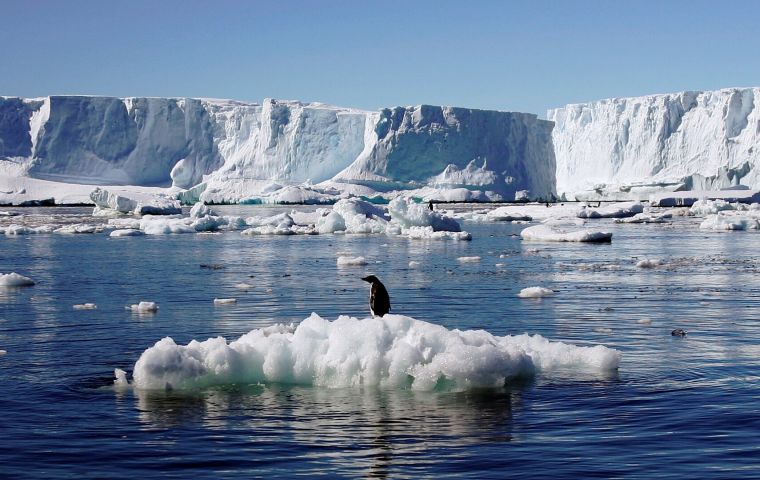MercoPress. South Atlantic News Agency
New discoveries in Antarctica shed light on climate change's impact
 The finding means better predictions could be made on how the continent’s ice sheets may behave if global warming continues unchecked
The finding means better predictions could be made on how the continent’s ice sheets may behave if global warming continues unchecked Researchers from Imperial College London have described a recent discovery in Antarctica as a clear sign of the loss of ice as a consequence of climate change. In their expert opinion, the newly-found 460-kilometer-long (285 miles) river under the Antarctic ice has accelerated the loss of ice mass.
This discovery was made in an area almost unreachable in East and West Antarctica that goes as far as the Weddell Sea. Key to this finding was the use of airborne radar soundings that can scan through ice. “We are now beginning to understand that there are whole systems down there, interconnected by vast river networks, just as they might be if there weren't thousands of meters of ice on top,” said scientist Martin Siegert, one of the authors of the research and a scientist at Imperial College London.
The mysterious river was detected by flying an aircraft over Antarctica to gather radar data, which they combined with models of how water would move on the continent.
The team determined that the hidden river flows at three times the rate of the river Thames in London.
The finding, which was shared in a paper published in Nature Geosciences last month, means the underside of Antarctica's ice has more active water flow than scientists previously understood. This could make it more susceptible to human-caused climate change.
Siegert also mentioned that this fluvial system could be the cause of the melting in this part of Antarctica. “How much of this ice melts and how fast it melts is related to how slippery the base of the ice is,” he explained. The significance of this study is that there would be enough ice in the reference region of the study to raise the global sea level by more than four meters. The team leading the research is already working to find out if there are more rivers under the ice.
In Greenland, for example, warm summer temperatures melt ice from the top, causing large amounts of water to flow from the surface and filter down through deep crevasses. In Antarctica, however, the summers are colder, and the ice’s surface does not melt much. Because of this, scientists had assumed there was not much water underneath the ice sheets.
The study also suggests that Antarctica melts at the base of the ice sheets, which in turn causes the formation of these rivers. A formation of fresh water that, if under high pressure, can accelerate the ice melting process as the base of the glacier becomes unstable. The four ice masses that support the river system are Institute Ice Stream, Mӧller Ice Stream, Support Force Glacier, and Foundation Ice Stream/Academy Glacier.
The research showed Antarctica’s ice is melting from the bottom, caused by friction as it rubs against the land, as well as by natural geothermal heat from the Earth. The scientists determined that the amount of melting ice is not huge—no more than a few millimeters per year. But since the ice’s surface area is so large, even a millimeter of meltwater can add up to a massive, fast-moving river.
This research comes months after NASA's Earth Observatory discovered that a large expanse of sea ice broke off the Antarctic Peninsula after more than 10 years anchored to the coast. Scientists pointed to the possibility that the southern hemisphere summer, which was warm and wet, could have been the cause of this melting.
Earlier this month, the world's arguably largest iceberg reappeared in the Drake Passage. The so-called A-76A iceberg has appeared in the Sickle Sea, the stretch of sea that separates South America from Antarctica. It is currently about 500 kilometers north of its natural position. The main iceberg of iceberg A-76 broke off from Antarctica's Ronne Ice Shelf in May 2021.
According to the Aquae Foundation, Antarctica is the part of the Earth that suffers the most from global warming. The average temperature of the planet's surface has risen since the end of the 19th century by 1.1 degrees Celsius. A change that has occurred to date as a result of increased carbon dioxide, and other emissions into the atmosphere made by humans. In Antarctica, for example, the climate has increased by 3° C.
The river is a significant boost to scientists’ understanding of Antarctica’s subglacial hydrology, which means better predictions could be made on how the continent’s ice sheets may behave if global warming continues unchecked.




Top Comments
Disclaimer & comment rulesCommenting for this story is now closed.
If you have a Facebook account, become a fan and comment on our Facebook Page!